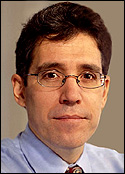There’s no question in my mind that only a small percentage of companies will reap all the enormous potential benefits of RFID technology. Most other companies will achieve incremental savings and improvements in efficiencies. And a few laggards will bungle their implementation so badly, or wait so long before deploying,
that they’ll go out of business.
What will separate the few from the many? Leadership.
In this issue’s case study, Dick Cantwell, the VP leading Gillette’s RFID efforts, talks about how critical the support of his company’s chairman, James Kilts, has been to the project (see Gillette Sharpens Its Edge). Kilts doesn’t want just to meet Wal-Mart’s mandate; he’s striving to achieve breakthrough benefits from RFID in the supply chain. His vision is to use RFID to create a “structured process” that will enable Gillette to achieve “results that are not predictable based on past experiences.”
Gillette has been a great company with great brands and products for the past 100 years. Kilts is working to sustain that greatness for another century by transforming the way his company gets its products to market and by providing its retail customers with world-class service. He has a strategy that’s guiding the way Gillette deploys RFID technology.
CEOs around the world are waking up to the fact that RFID is coming and that sooner or later they will have to deploy the technology. Most seem confused and unsure of how to proceed. Our cover story, Think Strategically, spells out three broad strategies, with suggestions on how to tailor each to a company’s role in the market. CEOs need to choose one of these strategies as the guiding philosophy behind their implementation.
A smart strategy for deploying RFID technology is a necessary first step. But a CEO can’t just set up a steering committee, explain the strategy and move on to other matters. In 10 Things CEOs Must Know, we explain why and clarify the big-picture issues that will help CEOs turn a strategy into a successful implementation.
CEOs who “get it” will embrace RFID as a tool they can use to cut costs, boost efficiencies and fundamentally improve the way they do business. They will encourage innovation. But they will align changes in their operations with their company’s goals.
RFID can’t transform a company. Only the CEO can do that. Over the next few years, we will see leaders emerge who will push RFID into every area of their business, the way John Chambers used Internet technologies to dramatically improve efficiencies at Cisco Systems. We will see CEOs who make RFID a key tool in their company’s efforts to provide unprecedented levels of customer service. And we’ll see those who use RFID to outflank the competition and take market share. In short, we are going to see some CEOs displaying true leadership. It will be their companies—and their shareholders—that get the most benefits from RFID.
Mark Roberti
Founder and Editor


